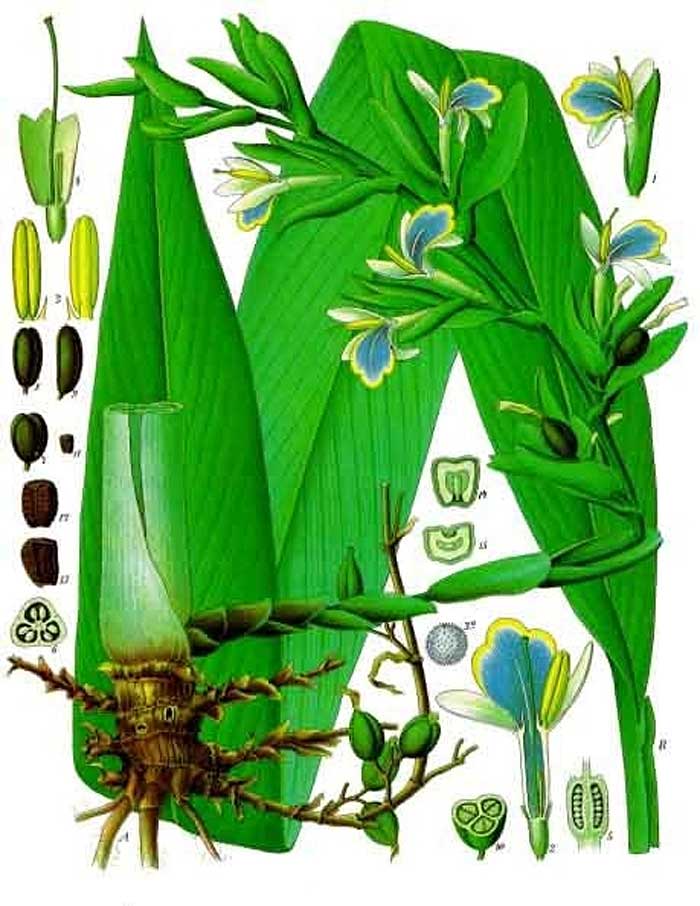
Classification System: APG IV
Superregnum: Eukaryota
Regnum: Plantae
Cladus: Angiosperms
Cladus: Monocots
Cladus: Commelinids
Ordo: Zingiberales
Familia: Zingiberaceae
Subfamilia: Alpinioideae
Tribus: Alpinieae
Genus: Elettaria
Species: Elettaria cardamomum
Name
Elettaria cardamomum (L.) Maton
References
Trans. Linn. Soc. London 10:254, t. 5. 1811
USDA, ARS, National Genetic Resources Program. Germplasm Resources Information Network - (GRIN) [Online Database]. Online.
Vernacular names
беларуская: Кардамон
български: Кардамон
čeština: Kardamom
Deutsch: Kardamom
English: Cardamom
Esperanto: Kardamomo
eesti: Harilik kardemon
suomi: Kardemumma
français: Cardamome
magyar: Kardamomi mag
Bahasa Indonesia: Kapulaga
italiano: Cardamomo
日本語: カルダモン
mak: ᨀᨄᨘᨒᨁ
മലയാളം: ഏലം
Nederlands: Kardemom
norsk: Kardemomme
polski: Kardamon
português: Cardamomo
русский: Кардамон
slovenščina: Kardamom
svenska: Kardemumma
Türkçe: Kakule
Tiếng Việt: Tiểu đậu khấu
Elettaria cardamomum, commonly known as green or true cardamom, is a herbaceous, perennial plant in the ginger family, native to southern India. It is the most common of the species whose seeds are used as a spice called cardamom. It is cultivated widely in tropical regions and reportedly naturalized in Réunion, Indochina, and Costa Rica.[2][3][4][5]
Growth
ElettariaCardamomum.jpg
Elettaria cardamomum is a pungent, aromatic, herbaceous, perennial plant, growing to about 2–4 m (6 ft 7 in – 13 ft 1 in) in height. The leaves are alternate in two ranks, linear-lanceolate, 40–60 cm (16–24 in) long, with a long pointed tip. The flowers are white to lilac or pale violet, produced in a loose spike 30–60 cm (12–24 in) long. The fruit is a three-sided yellow-green pod 1–2 cm (0.39–0.79 in) long, containing several (15-20) black and brown seeds.
Use
The green seed pods of the plant are dried and the seeds inside the pod are used in Indian and other Asian cuisines, either whole or ground. It is the most widely cultivated species of cardamom; for other types and uses, see cardamom.
Cardamom pods as used as spice
True cardamom may have been used in Ayurveda medicine as early as the 4th century BC.[6] Ground cardamom is an ingredient in many Indian curries and is a primary contributor to the flavour of masala chai. In Iran and India, cardamom is used to flavour coffee and tea.
In addition to its native range, it is grown in Nepal, Vietnam, Cambodia, Thailand, Sri Lanka, and Central America. In India, the states of Sikkim and Kerala are the main producers of cardamom; they rank highest both in cultivated area and in production.
Ecology
E. cardamomum is used as a food plant by the larvae of the moth Endoclita hosei.[7]
Varieties
Cardamom plant
The three natural varieties of green cardamom plants are:
Malabar (Nadan/native), as the name suggests, is the native variety of Kerala. These plants have floral racemes (which bear the pods) that grow horizontally along the ground.
Mysore, as the name suggests, is a native variety of Karnataka. These plants have floral racemes which grow vertically upwards. The Mysore variety has declined, however, in the past few decades owing to the emergence of the more resistant and better-yielding 'Green Gold' variety, and which is the most common form of cardamom harvested in Kerala.
Vazhuka is a naturally occurring hybrid between Malabar and Mysore varieties, and the panicles grow neither vertically nor horizontally, but in between.
Recently, a few planters isolated high-yielding plants and started multiplying them on a large scale. The most popular high-yielding variety is 'Njallani', which is a unique high-yielding cardamom variety developed by an Indian farmer, Sebastian Joseph, at Kattappana in the South Indian state of Kerala.[8][9][10][11] K. J. Baby of Idukki District, Kerala, has developed a purely white-flowered variety of Vazhuka type green cardamom having higher yield than 'Njallani'. The variety has high adaptability to different shade conditions and can also be grown in waterlogged areas.[12]
References
Elettaria cardamomum - Köhler–s Medizinal-Pflanzen - Franz Eugen Köhler, Köhler's Medizinal-Pflanzen
"Kew World Checklist of Selected Plant Families". Apps.kew.org. Retrieved 2018-05-29.
Larsen, K. (1996). A prelimanary checklist of the Zingiberaceae of Thailand. Thai Forest Bulletin (Botany) 24: 35-49.
Dy Phon, P. (2000). Dictionnaire des plantes utilisées au Cambodge: 1-915. Chez l'auteur, Phnom Penh, Cambodia.
Nelson Sutherland, C.H. (2008). Catálogo de las plantes vasculares de Honduras. Espermatofitas: 1-1576. SERNA/Guaymuras, Tegucigalpa, Honduras.
Pickersgill, Barbara (2005). Prance, Ghillean; Nesbitt, Mark (eds.). The Cultural History of Plants. Routledge. p. 158. ISBN 0415927463.
Shaista Kokab and Shahid Ahmad (2011). "Developing Herbal Pharmaceutics in Pakistan – II: Distinctiveness of Selected Medicinal Herbs and Uses" (PDF). Managing Natural Resources for Sustaining Future Agriculture. 3 (21).[permanent dead link]
Unsung Hero: Tale of an ingenious farmer, www.rediff.com, 30 May 2007.
"New cardamom variety – Njallani", National Innovation Foundation, Idukki, Kerala, India: Department of Science and Technology
"Poor rainfall may hit cardamom crop". The Hindu Business Line. 6 July 2007.
"Cardamom: Scientists, Njallani developers fight". CommodityOnline. 8 January 2008.
"White Flowered Cardamom Variety" (PDF), Fourth National Technological Innovations & Traditional Knowledge Awards, India: National Innovation Foundation, Department of Science and Technology, archived from the original (PDF) on 2013-05-17
Retrieved from "http://en.wikipedia.org/"
All text is available under the terms of the GNU Free Documentation License

